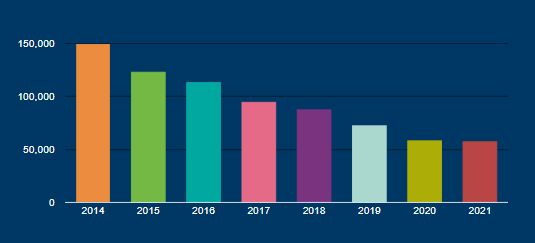The most up-to-date data currently available on the use of animals in research and testing in the UK was published on 30 June 2022. A total of 3.06 million scientific procedures were completed on animals in 2021, which is an increase of 6% from the 2.88 million procedures in 2020. This is due to two national lockdowns during 2020, which affected activity at research establishments.
However, it was positive to see that the percentage of ‘severe’ procedures fell once again, from 4% of all experimental procedures in 2020 to 3.4% in 2021. Below is a summary of the data on the number of animals reported to have experienced ‘severe’ suffering, and in which areas of science.
As in previous years, more mice experience ‘severe’ pain, suffering, distress or lasting harm than any other species. The percentage of guinea pigs experiencing severe suffering is highest, because of the use of this species in quality control batch potency testing. Batch potency testing of vaccines and other substances (such as botulinum toxin) is the category responsible for the most uses of animals reported as ‘severe’.
58,003 experimental procedures using animals (3.4% of the total) were reported as causing ‘severe’ pain, suffering, distress or lasting harm
40,126 for regulatory purposes (11% of all use for regulatory purposes was ‘severe’)
12,003 in basic research
5,874 in applied research
Main categories of research and testing involving severe suffering
(data represent the number of ‘procedures’ undertaken that were reported as causing ‘severe’ suffering)
31,645 Batch potency testing
5,067 Acute and sub-toxicity tests
2,870 Immune system
2,613 Cardiovascular system
2,041 Human infectious disorders
Which animals experienced the most ‘severe’ suffering?
(data represent the number of ‘procedures’ undertaken involving those animals)
48,090 Mice (5.2 % of all mouse use was ‘severe’)
1,145 Rats
1,256 Guinea pigs (25.6% of all guinea pig use was ‘severe’)
6,318 Fish
In addition, 28,782 (2.2%) of the procedures involved in the creation of new lines, and maintenance of established lines, of genetically altered animals (not used in experimental procedures) were categorised as ‘severe’.
Source: Home Office Annual Statistics of Scientific Procedures on Living Animals, Great Britain, 2021 – published 30 June 2022
